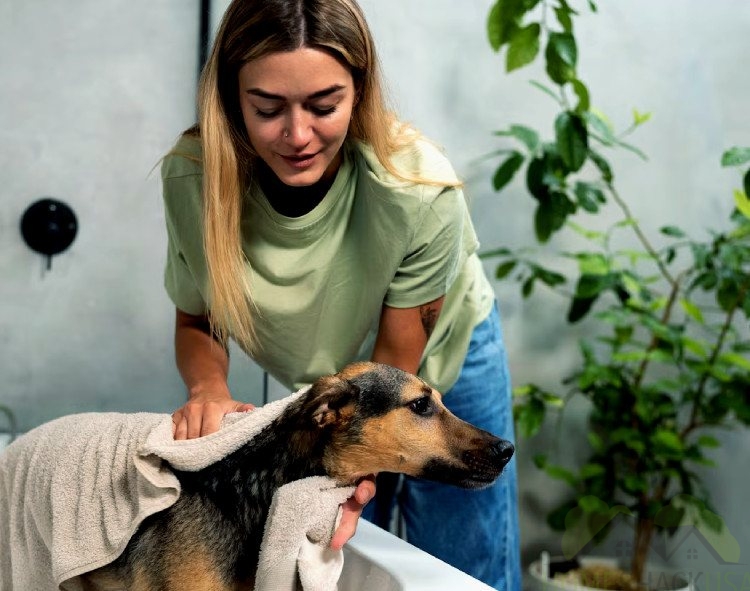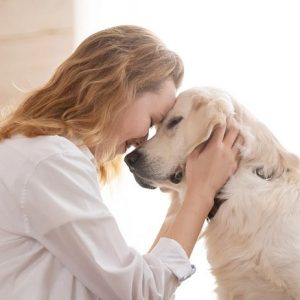Bathing your dog is an essential aspect of responsible pet care, contributing to their overall health and well-being.
From choosing the right water temperature to selecting suitable shampoos and addressing seasonal considerations, here’s a comprehensive guide to ensure your furry friend enjoys a clean and comfortable bathing experience.
Choosing the right water
One of the most crucial aspects when planning to bathe your dog is creating the appropriate environment, starting from adjusting the water temperature to setting up the bathing area.
How warm should be the water
Use lukewarm water, as dogs are more sensitive to temperature extremes than humans. It’s crucial to avoid water that is too hot or too cold to prevent discomfort.
The ideal water temperature for bathing your dog is around 100°F (38°C). This temperature is comfortable for your pet, helping to prevent any discomfort or shock from hot or cold water.
Always test the water with your hand before bathing your dog to ensure it is neither too hot nor too cold. Additionally, consider the ambient room temperature to make the bathing experience pleasant for your furry friend.
If you’re unsure, consulting with your veterinarian can provide specific guidance based on your dog’s breed, size, and individual preferences.
Bathing location
Choosing the right bathing location for your dog is crucial. Opt for a tub or a designated dog bathing area to create a controlled environment.
This ensures a more convenient and comfortable experience for both you and your furry friend. Having a dedicated space facilitates the process, making it easier to manage and enjoyable for your dog.
The choice of a specific bathing location has a strong psychological effect, as it allows your dog to alleviate a significant amount of the stress associated with bathing.
Preparing the bath
Before you begin bathing your pet, consider the following important details:
Non-slip surface
Place a non-slip mat at the bottom of the tub to ensure your dog feels secure and prevent slips. Similarly to humans, dogs would feel very uncomfortable on slippery surfaces.
Grooming tools
Have your grooming tools, such as a comb and brush, within easy reach to address any tangles during the bathing process.
Choosing the right shampoo
Opt for a dog-specific shampoo to cater to their unique coat and skin needs. Consult your veterinarian if your dog has specific skin conditions requiring specialised products.
It is generally not recommended to use human shampoo on dogs. Human shampoos are formulated for the pH level of human skin, which differs from that of dogs.
Using human shampoo on dogs can strip their skin of natural oils, leading to dryness and irritation. Dogs have more sensitive skin, and their fur requires specific care.
Bathing process – step by step
To bathe your dog, follow these steps:
1.Wetting the coat
Wet your dog’s coat thoroughly, starting from the neck and working your way down. Use a handheld showerhead or a container to pour water gently.
2.Applying shampoo
Dilute the shampoo according to the product instructions, and apply it evenly across your dog’s coat, avoiding sensitive areas like the eyes and ears.
3.Massaging and rinsing
Massage the shampoo into your dog’s coat, paying attention to areas where dirt and debris may accumulate. Rinse the coat thoroughly to ensure no shampoo residue remains.
Drying your dog
Once the dog is bathed, it’s time for the drying process.
Towel drying
Towel dry your dog immediately after the bath. Use absorbent towels and pat the coat dry rather than rubbing to avoid tangling.
Air drying
Allow your dog to air dry naturally or use a blow dryer on a low, cool setting. Ensure the dryer is at a comfortable distance to prevent overheating. In most cases dogs don’t enjoy the dryer so you need to be very careful and gentle.
Seasonal considerations
Bathing your dog can vary significantly across different seasons.
Winter bathing
During winter, ensure the bathing area is warm, and use slightly warmer water. Dry your dog thoroughly to prevent them from getting chilled.
Summer bathing
During warm weather, choose cooler water and use the bathing process as a means to refresh your dog in the heat of the day.
Additional tips
To make bathing even easier, keep the following in mind:
Frequency of bathing
Regular bathing depends on your dog’s breed, lifestyle, and individual needs. Some dogs may need baths more frequently than others.
Positive reinforcement
Use treats and positive reinforcement to create a positive association with bath time, making it a more enjoyable experience for your dog.
Professional grooming
For dogs with specific grooming needs or those averse to home bathing, consider professional grooming services.
By following these guidelines, you can turn bath time into a positive and enjoyable routine for both you and your canine companion, ensuring they stay clean, healthy, and happy.





